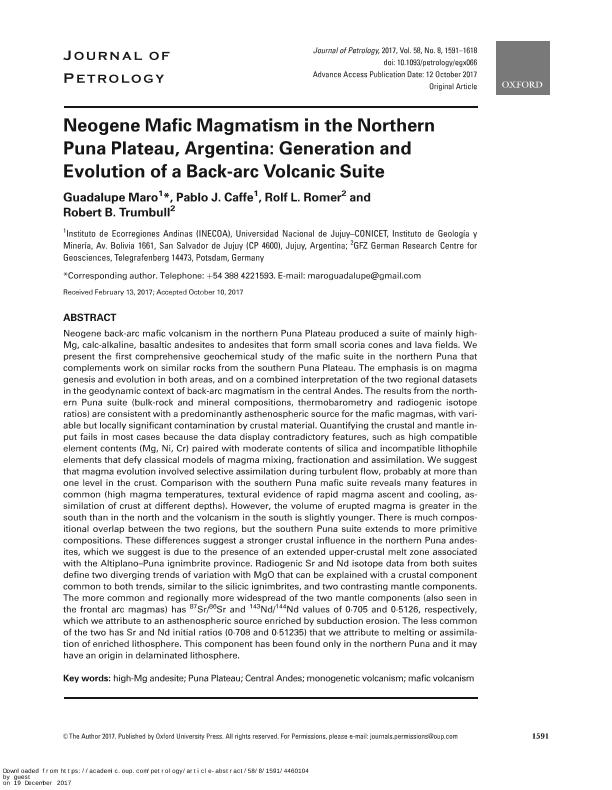Artículo
Neogene Mafic Magmatism in the Northern Puna Plateau, Argentina: Generation and Evolution of a Back-arc Volcanic Suite
Fecha de publicación:
08/2017
Editorial:
Oxford University Press
Revista:
Journal Of Petrology
ISSN:
0022-3530
Idioma:
Inglés
Tipo de recurso:
Artículo publicado
Clasificación temática:
Resumen
Neogene back-arc mafic volcanism in the northern Puna Plateau produced a suite of mainly high-Mg, calc-alkaline, basaltic andesites to andesites that form small scoria cones and lava fields. We present the first comprehensive geochemical study of the mafic suite in the northern Puna that complements work on similar rocks from the southern Puna Plateau. The emphasis is on magma genesis and evolution in both areas, and on a combined interpretation of the two regional datasets in the geodynamic context of back-arc magmatism in the central Andes. The results from the northern Puna suite (bulk-rock and mineral compositions, thermobarometry and radiogenic isotope ratios) are consistent with a predominantly asthenospheric source for the mafic magmas, with variable but locally significant contamination by crustal material. Quantifying the crustal and mantle input fails in most cases because the data display contradictory features, such as high compatible element contents (Mg, Ni, Cr) paired with moderate contents of silica and incompatible lithophile elements that defy classical models of magma mixing, fractionation and assimilation. We suggest that magma evolution involved selective assimilation during turbulent flow, probably at more than one level in the crust. Comparison with the southern Puna mafic suite reveals many features in common (high magma temperatures, textural evidence of rapid magma ascent and cooling, assimilation of crust at different depths). However, the volume of erupted magma is greater in the south than in the north and the volcanism in the south is slightly younger. There is much compositional overlap between the two regions, but the southern Puna suite extends to more primitive compositions. These differences suggest a stronger crustal influence in the northern Puna andesites, which we suggest is due to the presence of an extended upper-crustal melt zone associated with the Altiplano?Puna ignimbrite province. Radiogenic Sr and Nd isotope data from both suites define two diverging trends of variation with MgO that can be explained with a crustal component common to both trends, similar to the silicic ignimbrites, and two contrasting mantle components. The more common and regionally more widespread of the two mantle components (also seen in the frontal arc magmas) has <sup>87</sup>Sr/<sup>86</sup>Sr and <sup>143</sup>Nd/<sup>144</sup>Nd values of 0·705 and 0·5126, respectively, which we attribute to an asthenospheric source enriched by subduction erosion. The less common of the two has Sr and Nd initial ratios (0·708 and 0·51235) that we attribute to melting or assimilation of enriched lithosphere. This component has been found only in the northern Puna and it may have an origin in delaminated lithosphere.
Archivos asociados
Licencia
Identificadores
Colecciones
Articulos(INECOA)
Articulos de INSTITUTO DE ECORREGIONES ANDINAS
Articulos de INSTITUTO DE ECORREGIONES ANDINAS
Citación
Maro, Guadalupe; Caffe, Pablo Jorge; Romer, Rolf L; Trumbull, Robert B; Neogene Mafic Magmatism in the Northern Puna Plateau, Argentina: Generation and Evolution of a Back-arc Volcanic Suite; Oxford University Press; Journal Of Petrology; 58; 8; 8-2017; 1591-1617
Compartir
Altmétricas




